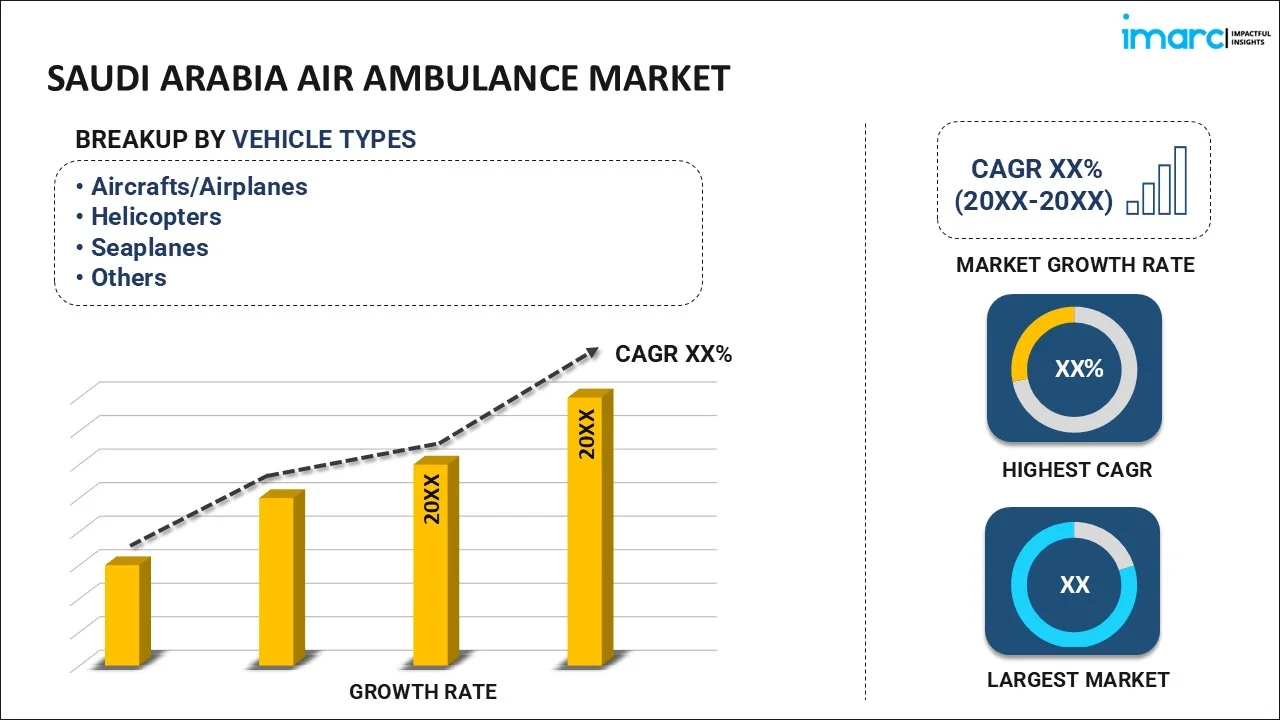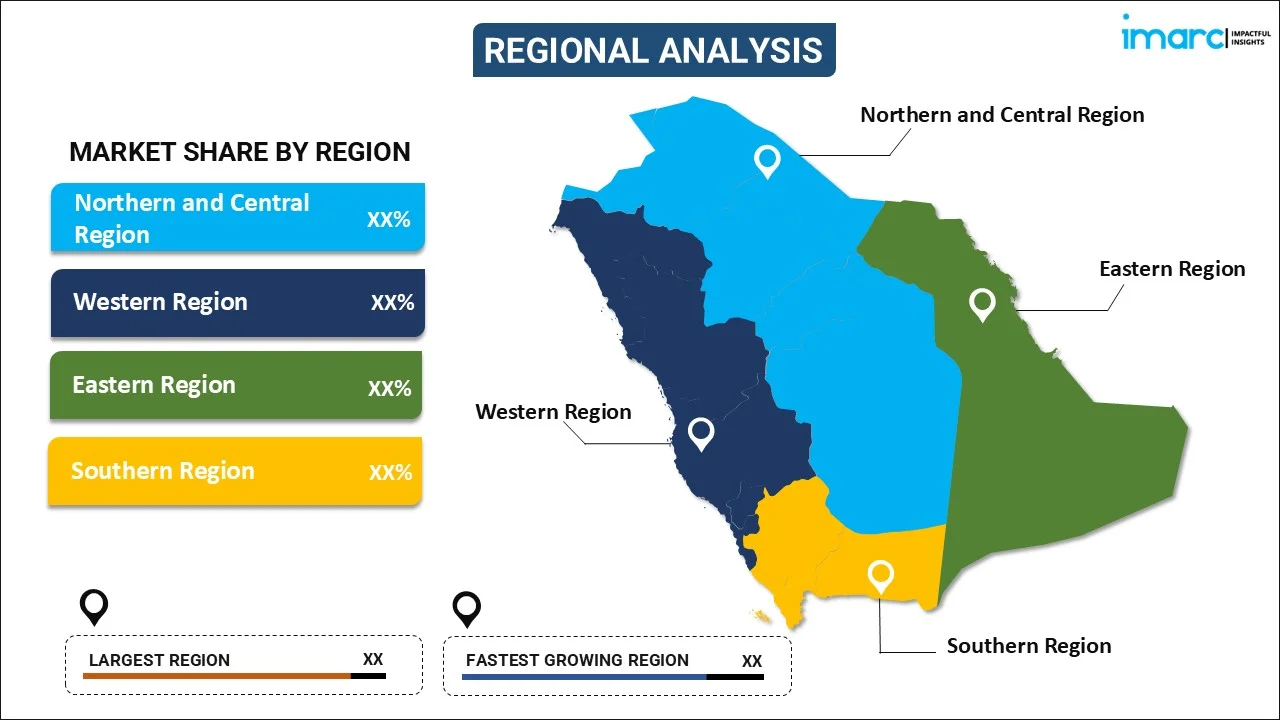
Saudi Arabia Air Ambulance Market Size, Share, Trends and Forecast by Vehicle Type, Service Type, Application, and Region, 2025-2033
Saudi Arabia Air Ambulance Market Overview:
The Saudi Arabia air ambulance market size reached USD 59.40 Million in 2024. Looking forward, IMARC Group expects the market to reach USD 137.90 Million by 2033, exhibiting a growth rate (CAGR) of 9.80% during 2025-2033. The growing adoption of advanced medical equipment and technology and expansion of healthcare infrastructure are propelling the market growth. Besides this, Saudi Arabia air ambulance market share is influenced by the increasing implementation of government policies and rising population in the region.
|
Report Attribute
|
Key Statistics
|
|---|---|
|
Base Year
|
2024 |
|
Forecast Years
|
2025-2033
|
|
Historical Years
|
2019-2024
|
| Market Size in 2024 | USD 59.40 Million |
| Market Forecast in 2033 | USD 137.90 Million |
| Market Growth Rate (2025-2033) | 9.80% |
Saudi Arabia Air Ambulance Market Trends:
Technological Advancements in Air Ambulance Equipment
The increasing adoption of advanced medical equipment and technology is supporting the Saudi Arabia air ambulance market growth. The integration of state-of-the-art medical devices in aircraft ensures that patients receive critical care comparable to what is available in hospital intensive care units. This technological enhancement encompasses life-support systems, telemedicine capabilities, and automated diagnostic tools. These developments play a crucial role in streamlining operations and improving patient survival rates during emergency transport. Leading manufacturers are introducing aircraft equipped with high-end life-support systems that include ventilators, defibrillators, and advanced cardiac monitoring systems designed specifically for aviation use. The integration of telemedicine in air ambulances is also increasing, allowing remote medical teams to consult in real-time during patient transport. This innovation helps optimize treatment plans and ensure that patients receive the best possible care while enroute to medical facilities. As per the predictions of the IMARC Group, the Saudi Arabia telemedicine market is projected to exhibit a growth rate (CAGR) of 15.40% during 2024-2032. Furthermore, partnerships between air ambulance service providers and technology companies are rising. These collaborations focus on equipping air ambulances with enhanced digital solutions that support diagnostics and in-flight data collection, facilitating better patient outcomes.
Rising Demand for Emergency Medical Services (EMS)
The population growth and increase in healthcare infrastructure in Saudi Arabia are driving the demand for emergency medical services such as air ambulances. The rising rate of chronic diseases, road traffic accidents, and other emergencies call for effective and timely response mechanisms. Air ambulances fill the gap between accident locations or distant locations and specialized medical facilities, thus being a vital part of the healthcare system. Currently, this demand is fueling several service introductions focused on increasing EMS coverage. Key service providers are entering the marketplace with increased fleet capabilities to deliver quicker response times. These new services tend to utilize rotor-wing aircraft for intercity and urban transfers and fixed-wing aircraft for long-distance and international patient transports. Several advances are made in scheduling systems and dispatch algorithms to maximize resource utilization of air ambulances and deliver immediate response to medical emergencies. In addition, air ambulances are not solely utilized to rescue human but also offer emergency services to animals. For example, in 2024, Saudi Red Cresent's air ambulance crew saved a camel herder hurt in a remote desert region close to Al-Bu'itha mine after receiving a desperate appeal from a resident. The Qibah ground ambulance sped to the location, providing first aid and creating a safe landing site in the desert for the air ambulance.
Government Initiatives and Policy Support
Government policies and initiatives are influencing the Saudi Arabia air ambulance market outlook. The government is recognizing the strategic importance of air medical services in the broader healthcare landscape, leading to increased investment in this sector. The Vision 2030 initiative plays a pivotal role in enhancing the overall healthcare infrastructure including air ambulance services. The emphasis is on improving capabilities to handle medical emergencies efficiently and reduce response times across the nation, especially in less accessible areas. Vision 2030 proposes investing US$ 1.5 billion in health information technology (IT) and telemedicine to further improve the overall healthcare system of Saudi Arabia. Moreover, several noteworthy government initiatives are launched to bolster the air ambulance sector. Government funding is also facilitating the procurement of advanced aircraft and equipment, ensuring that both public and private service providers can operate with cutting-edge medical tools. These policy changes are promoting an environment that encourages innovation and investment in the market. Additionally, strategic initiatives are focussing on workforce training programs, ensuring that air ambulance staff are equipped with specialized knowledge and skills required for high-stakes patient transport.
Saudi Arabia Air Ambulance Market Segmentation:
IMARC Group provides an analysis of the key trends in each segment of the market, along with forecasts at the regional level for 2025-2033. Our report has categorized the market based on Vehicle Type, Service Type, and Application.
Vehicle Type Insights:

- Aircrafts/Airplanes
- Rotary Wing
- Fixed Wing
- Helicopters
- Seaplanes
- Others
The report has provided a detailed breakup and analysis of the market based on the vehicle type. This includes aircrafts/airplanes (rotary wing and fixed wing), helicopters, seaplanes, and others.
Service Type Insights:
- Hospital Services
- Community Services
- Others
A detailed breakup and analysis of the market based on the service type have also been provided in the report. This includes hospital services, community services, and others.
Application Insights:
- Medical Care
- Transport
- Others
A detailed breakup and analysis of the market based on the application have also been provided in the report. This includes medical care, transport, and others.
Regional Insights:

- Northern and Central Region
- Western Region
- Eastern Region
- Southern Region
The report has also provided a comprehensive analysis of all the major regional markets, which include Northern and Central Region, Western Region, Eastern Region, Southern Region.
Competitive Landscape:
The market research report has also provided a comprehensive analysis of the competitive landscape. Competitive analysis such as market structure, key player positioning, top winning strategies, competitive dashboard, and company evaluation quadrant has been covered in the report. Also, detailed profiles of all major companies have been provided.
Saudi Arabia Air Ambulance Market News:
- In June 2024, Saudi Arabia launched an air ambulance service to improve healthcare for pilgrims during the Hajj season of 2024. The goal of the air ambulance service is to guarantee the safety and wellness of pilgrims by responding rapidly to medical emergencies, offering specialized treatment, and efficiently transferring patients to advanced healthcare facilities.
- In September 2023, Saudi Arabian aviation services provider The Helicopter Company (THC) highlighted its partnership with the Saudi Red Crescent Authority (SRCA) in delivering helicopter emergency medical services (HEMS) at the Saudi Emergency Medical Services (SEMS) conference.
Saudi Arabia Air Ambulance Market Report Coverage:
| Report Features | Details |
|---|---|
| Base Year of the Analysis | 2024 |
| Historical Period | 2019-2024 |
| Forecast Period | 2025-2033 |
| Units | Million USD |
| Scope of the Report |
Exploration of Historical Trends and Market Outlook, Industry Catalysts and Challenges, Segment-Wise Historical and Future Market Assessment:
|
| Vehicle Types Covered |
|
| Service Types Covered | Hospital Services, Community Services, Others |
| Applications Covered | Medical Care, Transport, Others |
| Regions Covered | Northern and Central Region, Western Region, Eastern Region, Southern Region |
| Customization Scope | 10% Free Customization |
| Post-Sale Analyst Support | 10-12 Weeks |
| Delivery Format | PDF and Excel through Email (We can also provide the editable version of the report in PPT/Word format on special request) |
Key Questions Answered in This Report:
- How has the Saudi Arabia air ambulance market performed so far and how will it perform in the coming years?
- What is the breakup of the Saudi Arabia air ambulance market on the basis of vehicle type?
- What is the breakup of the Saudi Arabia air ambulance market on the basis of service type?
- What is the breakup of the Saudi Arabia air ambulance market on the basis of application?
- What are the various stages in the value chain of the Saudi Arabia air ambulance market?
- What are the key driving factors and challenges in the Saudi Arabia air ambulance market?
- What is the structure of the Saudi Arabia air ambulance market and who are the key players?
- What is the degree of competition in the Saudi Arabia air ambulance market?
Key Benefits for Stakeholders:
- IMARC’s industry report offers a comprehensive quantitative analysis of various market segments, historical and current market trends, market forecasts, and dynamics of the Saudi Arabia air ambulance market from 2019-2033.
- The research report provides the latest information on the market drivers, challenges, and opportunities in the Saudi Arabia air ambulance market.
- Porter's five forces analysis assist stakeholders in assessing the impact of new entrants, competitive rivalry, supplier power, buyer power, and the threat of substitution. It helps stakeholders to analyze the level of competition within the Saudi Arabia air ambulance industry and its attractiveness.
- Competitive landscape allows stakeholders to understand their competitive environment and provides an insight into the current positions of key players in the market.
Need more help?
- Speak to our experienced analysts for insights on the current market scenarios.
- Include additional segments and countries to customize the report as per your requirement.
- Gain an unparalleled competitive advantage in your domain by understanding how to utilize the report and positively impacting your operations and revenue.
- For further assistance, please connect with our analysts.
 Inquire Before Buying
Inquire Before Buying
 Speak to an Analyst
Speak to an Analyst
 Request Brochure
Request Brochure
 Request Customization
Request Customization




.webp)




.webp)












